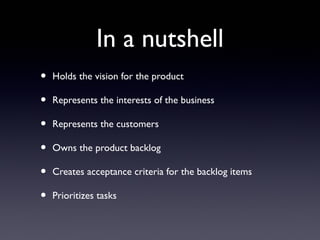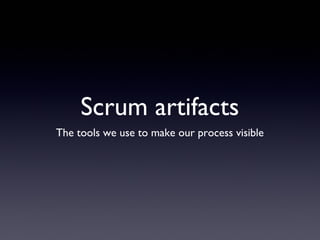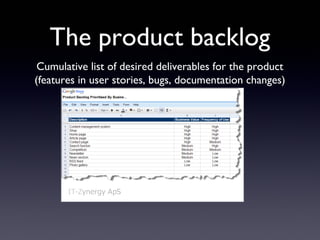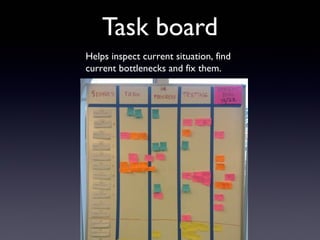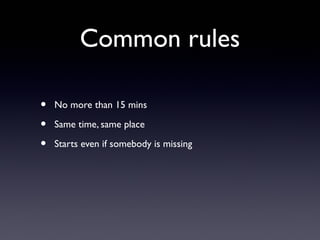Scrum
- 1. Scrum “Inspect and adapt” framework
- 2. Who uses it? • Afisha • Adobe - use it in all of their developments, now, and began with Adobe Lifecycle, Adobe Soundbooth and Adobe Audition • Adwords in Google • Epam systems widely use Scrum • Amazon is heavily using Scrum in almost every layer of their business • Microsoft widely use Scrum for software development
- 3. Overview • Average team size 7 +/-2 • 3 roles • Product owner • The team • Scrum Master • 3 ceremonies • Sprint planning • Daily meeting • Sprint review
- 5. Some history • Was defined in 1986 by american professors Hirotaka Takeuchi and Ikujiro Nanaka in their paper “The new software development game” • Based on case studies from manufacturing firms in the automotive, photocopier and printer industries (Fuji-Xerox, Honda,Toyota, Canon etc.) • First Documented in 1993 by Jeff Sutherland, John Scumniotales and Jeff McKenna. Sutherland formalized a Scrum process and influened to Kent Beck a XP programming founder • According to the 7th Annual State of Agile Development Survey, scrum or variants of scrum are still the most popular agile methodologies used. Out of the 4,048 software professionals that responded, 72% are practicing scrum or some kind of hybrid
- 6. Work as a whole team
- 7. • Product owner • Scrum master • Development team Roles
- 8. Product owner “The voice of the customers” TextText with user stories
- 9. ... and voice of the business He takes the stories that have the most business value
- 10. In a nutshell • Holds the vision for the product • Represents the interests of the business • Represents the customers • Owns the product backlog • Creates acceptance criteria for the backlog items • Prioritizes tasks
- 11. Scrum master “Servant leader” “Servant leader”
- 12. Not the team boss Priority - high-performing, self-organized team
- 13. What does he do? • Removes impediments to the ability of team to deliver sprint goals • Insures that scrum process is used as intended • Facilitates changes
- 14. “One for one and one for all” “One for one and one for all”
- 15. In a nutshell • Complete user stories to incrementally increase the value of the product • Self-organizes to get all of the necessary work done • Creates the estimates • Owns the “how to do the work” decisions • Avoid “not my job” thinking
- 16. Scrum artifacts The tools we use to make our process visible
- 17. The product backlog Cumulative list of desired deliverables for the product (features in user stories, bugs, documentation changes)
- 18. Product backlog item • An estimate as to how much work the story requires to implement • Acceptance criteria that will help us know when it has been implemented correctly Contains:
- 19. Sprint backlog • Finite life-span - length of current sprint • Has all the stories that the team has commited to accomplish in this sprint and their associated tasks • Stories -- unit of value. Somethings that team delivers • Tasks -- unit of work. Somethings that person delivers.
- 20. Task board Helps inspect current situation, find current bottlenecks and fix them.
- 23. Burndown charts • Shows relationship between time and scope • Shows us what if left to do
- 24. Definition of done • Scrum teams create their own definition of the word done for a user story • I.e. code witten, reviewed, unit and regression test passing, doc written, tester sign-off • Print out their definition of done as a checklist and post it next to their task board. • When the team thinks a story is done, they gather together and review each item.Then they declare the story as done.
- 25. The sprint cycle The foundational rhythm of the scrum process.
- 26. • Sprint planning • Daily standup meeting • Story time • Sprint review • Retrospective
- 27. Sprint planning • 1 part • What will we do? • Commit to a set of deliverables for the sprint • What will we do? • Product owner presents the stories • Team members discuss it and review acceptance criteria • 2 part • How will we do?
- 28. Daily standup meeting An inspect and adapt activity
- 29. Purpose Inspect and adapt the work to successfully complete sprint stories
- 30. Common rules • No more than 15 mins • Same time, same place • Starts even if somebody is missing
- 31. 3 questions • What tasks I’ve completed since the last daily scrum? • What tasks I expect to complete? • What obstacles are slowing me down?
- 32. Sprint demonstration Time to inspect and adapt the product
- 33. • Team shows the completed work • Stakeholders see how the product incrementally improved • Record feedback • Inspect & adapt!
- 34. Sprint retrospective Time to inspect and adapt the process
- 35. • What went good • What went bad • Identify and commit to a practical number of process improvement actions for next sprint










